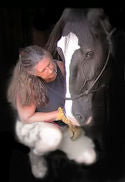High-Low Hoof Syndrome
We hear about high-low hooves a lot. Most horses have fairly similar hooves all round. Similar in shape, size, functioning but some will have ones that are apparently ‘mis-matched’.
This can be caused from different reasons.
Once again, one can’t separate the hooves from the rest of the horse so let’s first take a look at the whole horse reasons for high low syndrome.
First of all, if a horse has been injured in some way, the imbalances in the muscular-skeletal system as a result can and do affect how the hooves grow and how they function – as well as how the horse moves, of course. Having the horse assessed by a bodyworker and, if needed, a chiropractor can help to identify issues that are causing hoof challenges and correct them. Why would muscle spasms and skeletal imbalances (think subluxations) have anything to do with the hooves?


The hooves above show a high hoof and low hoof respectively.
So first, take a WHOLE BODY look to see what might be going on before simply chalking up the High-Low Syndrome to ‘bad hooves’.The hooves are constantly adapting to their environment and to the impact they give on the ground. Plain and simple. Couple uneven ground with an imbalanced body and there ya have it – imbalances in the hooves. Think of the horse that is always traveling with one foot more forward than the other or standing as such. That hoof will tend to grow forward and lower the heel just as a matter of physics. But the secret to find out WHY the horse is always traveling with one foot more forward than the other or WHY the horse is standing that way. If you set about merely looking at and trying to correct the hoof, well, then you’ll be trying to ‘fix’ the imbalances in the hooves for the rest of the horse’s life.
Secondly, we have to look to the body dominance of the horse – is he left or right ‘handed’? If the horse is dominant on the right side then he’s more likely to develop a long, low toe on the right front hoof and a more upright hoof on his weaker side, the left front hoof.
Good training and, again, body work or massage can go a long way in helping to correct this. Good training means to work the horse equally in both directions with a bit more work on the weaker side to help strengthen it.
Of course, the rider has everything to do with balance and the horse as well. That’s a tough call to make … to think that we, ourselves, may be causing the imbalance growth of the hooves. Whether it be simple rider fault/balance or poor saddle fit … I could always tell if the rider was imbalanced simply by taking a good look at the growth of the hooves each trim session.


Normal Hoof on the top; Low hoof on the bottom above. Notice the shortened toe and adequate heel on the 'normal' hoof and the long toe and low heel on the "low" hoof.
The most prominent reason for high-low syndrome may simply be the trimming of the hooves. Many times we hear, “oh, your horse has a clubbed foot.” Or “that’s just the way he grows his hooves” … and the trimmer or farrier goes on to trim within that reasoning. That simply exacerbates the whole situation and then we have the body responding to the poor trim which then starts a whole other challenge of dealing with the physical issues as outlined above as well as imbalanced trimming.
Sounds like a dog chasing its tail, doesn’t it?
I will have to say that 98% of my work on ‘high-low syndrome’ hooves was corrected in just a few months of good, balanced trimming coupled with full bodywork. I was usually called in when people got tired of having their horses lame or their hooves looking and functioning less than what they knew was possible. What I did, though, was to examine each hoof, individually, and ascertain what needed to be done on that particular hoof. No, hooves are not always perfectly the same on each horse. But most healthy hooves are pretty close to it. It’s important to trim for optimal functioning of each foot as the form of the hoof will follow how its functioning.
It’s also important to remember not to go too quickly. In other words, don’t try to bring the heels of the high foot down to match the low foot all in one session. The low foot needs to grow heel and have the toe shortened while the high foot will need to have the heels lowered over time. Trying to ‘carve’ the perfect hooves will only end up in sore-footed horses or worse.
Trimming hooves is not rocket science however, its not child’s play either. A good, solid education in anatomy and physiology of the hoof goes a long, long way in helping the hoofcare practitioner to be able to get your horses’ hooves in optimal condition. It helps a great deal, also, when the owners are observant and educate themselves as well. Then owner and trimmer are able to work together as a team to ‘get the job done and get it done correctly’.
Building a Supportive Barefoot Community
The team at Scoot Boot believe passionately in the barefoot horse and strive to build a supportive community of barefoot horse lovers.
Find more information about using Scoot Boots here.

Gwen Santagate is the author of "10 Secrets to Healthy Hooves" . For the last 37+ years, she has maintained healthy hooves with natural trimming on thousands of horses and specialized in pathological rehabilitation hoofcare for the last 18 years. She keeps a small herd of her own equines and continues to offer consults for horses in need.
